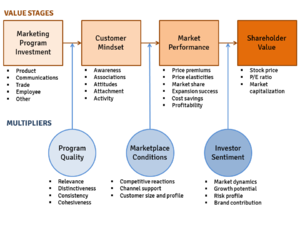Brand value chain
From CEOpedia | Management online
| Brand value chain |
|---|
| See also |
Brand value chain - is a version of a classic chain model of value with marketing activities analyzed in the context of brand value and customer value obtained through various marketing activities. Serves to evaluate market information, helps to track brand value from the first stage of marketing investment to the last, final stage of shareholder value, serves also to evaluate customer response to marketing activities and supports decision making in the marketing area.
Value Stages and Multiplier
Keller and Lehmann have created a model that allows you to analyze how your brand creates value:
- Value Stages
- Marketing investment program - concerns the impact on the way of thinking of the interested client. It is an investment in a given program which in the future will influence the value of the brand. Customer feedback is key. It is he who will judge how your brand perceives it, so it is important to focus on good company marketing through advertisements, promotions or marketing campaigns that will be tailored to the customer's needs at this stage. This is where good communication and customer relations count[1].
- Customer Mindset - that is, all the thoughts, feelings, attitudes and memories that a customer has in his mind about a given brand. At this stage it is important whether customers recognize the brand by name or logo, whether they are positively oriented towards it, whether they see the benefits of the brand, what is judged among others, or whether it is characteristic and prestige. Customer loyalty also plays an important role because the customers tied to the brand will be more likely to reach for their products and recommend them.
- Brand Performance - the effectiveness of the brand on the market obviously consists of positive opinions of customers, good advertising and publicity but also the most important element is not the revenue or a good capital base. When a brand has made a name for itself, it can carry out such operations as increasing the price of products or adding new, more expensive applications. This should not change the customer's opinion about the brand[2], but can strengthen it in the belief that the brand is on the top. On the other hand, the brand becomes profitable, so that you can reduce costs and save on advertising, because with an effective marketing program, the customer should already associate the brand with advertising.
- Shareholder - market performance affects shareholder value. Brand value depends on industrial and strategic decisions (such as, for example, increasing value) which are taken by management. It must take into account the needs of shareholders, because the higher the value for the shareholder, the better for the brand.
- Multiplier
- Quality Program - the first multiplier in the brand value chain. The quality of investment in the program depends on positive opinion and thinking of customers. So it is important to invest in marketing so that the brand becomes recognizable, fashionable or unique among other brands.
- Marketplace Conditions - in this point counts on what consumer gets the brand, what advantage they have over the competition.
- Investor Sentiment - the last multiplier already fully depends on the investors, and more precisely on their attitude to the brand. When the viewer's potential is able to value the brand better than the competitors. The level of risk with which the brand has already met or will meet is also determined here.
References
- Chaudhuri, A., & Holbrook, M. B. (2001). The chain of effects from brand trust and brand affect to brand performance: the role of brand loyalty. Journal of marketing, 65(2), 81-93.
- Kevin Lane Keller (2004). Brand value chain. Building Strong Brands: Three Models for Developing and Implementing Brand Plans, 13-16.
- Mary E.Barth, Michael B.Clement George Foster, Ron Kasznik (1998)Institutional Background and Related Research. Brand Values and Capital Market Valuation, 42-44.
Footnotes
- ↑ Kevin Lane Keller (2004). Brand value chain . Building Strong Brands: Three Models for Developing and Implementing Brand Plans, 13-16.
- ↑ Mary E.Barth, Michael B.Clement George Foster, Ron Kasznik (1998)Institutional Background and Related Research. Brand Values and Capital Market Valuation, 42-44.
Author: Kamila Wronkowska
